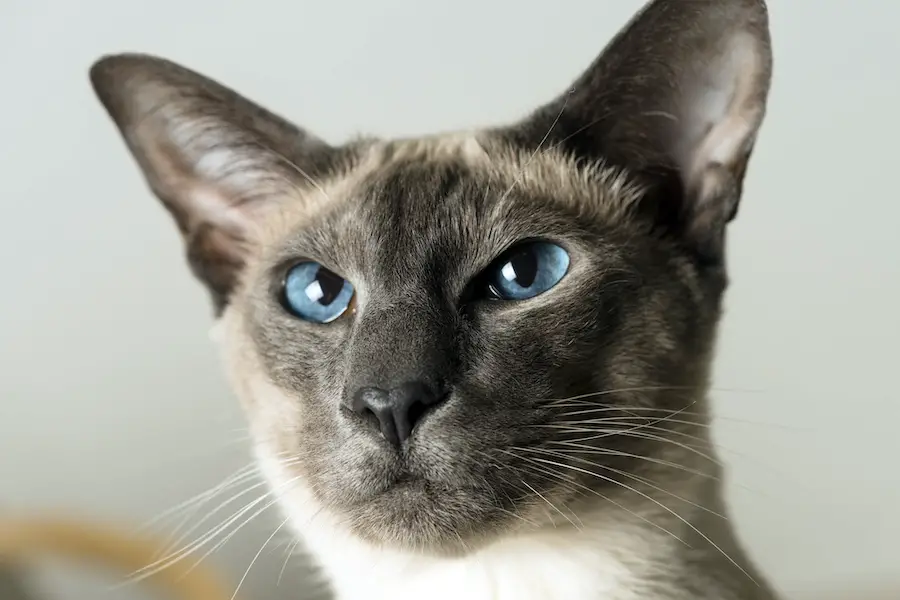Breed Quick Facts
Lifespan
11-20 Years
Average 15 Years
Size
Females 5-8 lbs
Males 8-12 lbs
Origin
Thailand
The Personality of Siamese Cats
Siamese cats are very smart animals that make great pets for people who want intelligent animals to keep them on their toes. This breed is known as the “Olympic gymnasts” of house cats for being able to climb on top of doors, refrigerators, cabinets…you name it! This trait makes it important to place not just ordinary household objects, but breakable ones on higher surfaces and out of reach of these fearless felines. Siamese cats are also very social and quickly become attached to their people, preferring to be around them at all times. Additionally, Siamese cats are energetic animals that will need plenty of playtime to keep them occupied.
History of The Siamese Cat
Siamese cats were originally bred to help control rodents around rice paddies in Thailand over 2000 years ago. The first Siamese cats were recorded in Siam (modern Thailand) and it is thought that the first Siamese cat brought to the West occurred in 1878 by David B. Sickels. Mr. Sickels worked as an American diplomat at the U.S. Consulate in Thailand. The cat, named Siam, was given to the wife and First Lady to President Rutherford B. Hayes. The first recognized breed standard for the Siamese cat was written on May 31st, 1908 by Harrison Weir.

What Do Siamese Cats Look Like?
Siamese cats have sleek bodies, long tails, and sharp features. The head of the Siamese is an equilateral triangle making their facial expression more distinctive compared to other breeds. Their eyes are almond-shaped with a dark pupil and vibrant blue iris. This breed of cat has short hair that doesn’t require much grooming. They can come in different colors such as blue, chocolate, and lilac. The Siamese cat has a distinctive voice that is often compared to the sound of a meowing baby. They are very active, intelligent, and enjoy being around people.
Breeds Related to the Siamese Cat
The Tonkinese is a cross between the Burmese and Siamese breeds. These cats have similar traits as both breeds and often fulfill the same roles as service animals for people with disabilities. The Balinese is a long-haired breed of the Siamese cat with a silky coat. They are often compared to the Persian cat due to their long coats and round face. The Himalayan is also closely related to the Siamese cat, although this breed has become larger than its original genetic pool.

Health Conditions Affecting Siamese Cats
Siamese cats are generally healthy with few genetic problems associated with the breed; however, they can be prone to certain conditions such as glaucoma if not given proper care.
A common medical condition that Siamese cats suffer from is polycystic kidney disease. According to the San Diego Zoo, this disorder causes the formation of clusters of cysts which can lead to renal failure. Symptoms include weight loss and will usually occur after the cat reaches 5 years of age. This genetic disorder can be prevented through selective breeding for Siamese cats with healthy genes. Siamese cats also have a tendency to develop glaucoma, an eye disease that causes fluid pressure in the eyes. If not treated, this condition leads to blindness over time. Siamese cats are also prone to dental disease and plaque. Although this is a problem for many breeds, Siamese cats have long been considered to be more vulnerable. Tartar build-up on the teeth and gums leads to gum disease and tooth decay. Regular brushing of your cat’s teeth will help prevent plaque from forming.

Conclusion
Siamese cats are one of the most popular cat breeds. They are incredibly affectionate, loving pets that make great family companions. People who have never owned a Siamese before are often drawn to them by their beauty and intrigued by their personalities. However, there are some key things that prospective owners should know before they rush out to get a Siamese cat.
Siamese cats are very social animals and crave attention from their human companions, who should provide them with plenty of physical affection on a daily basis. In return, Siamese cats will make people part of their feline family by taking to them quickly and easily! Siamese cats do best when they live indoors and are cared for by their owners. People who do not have the time to dedicate to bonding with their Siamese cat should think twice before getting one – these animals need care and attention seven days a week!
Siamese cats also take well to other animals in their families, such as dogs and other cats. However, care should be taken when Siamese cats are introduced to other animals. If a potential owner already has a dog and is thinking about getting a siamese cat, they should make sure that the dog gets along with the cat before bringing them home! Siamese cats can also be quite vocal, which may annoy some people who are used to less chatty pets.
Overall, owning a Siamese cat is an excellent experience that can bring light and happiness to any home! The attention, affection, and companionship that they provide would be well worth it for any animal lover!
